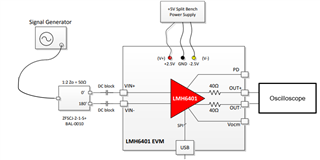Hi, I am working on a Eval board LHM6401 Variable gain amplifier. In the datasheet it is mentioned that the eval board works on both single as well as dual supply, but I am not able to obtain any gain when trying for single input supply. Can you help me out troubleshooting this?
Please note that, I have connected ground to V-.I have used proper baluns to ensure differential RF input. I am not using VCOM so I have left it open and I have provided a proper DC input of 5V.


